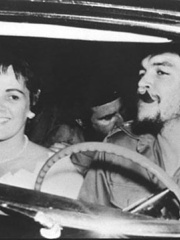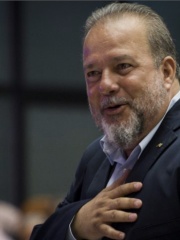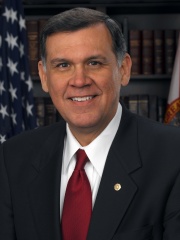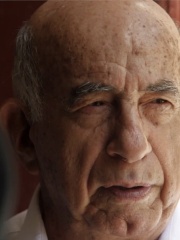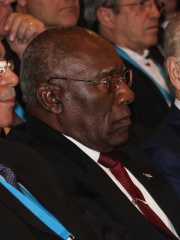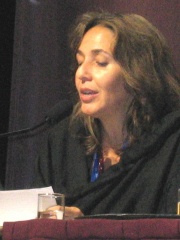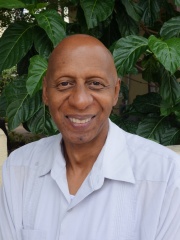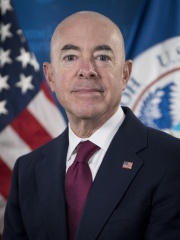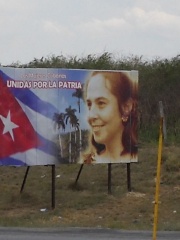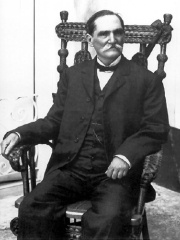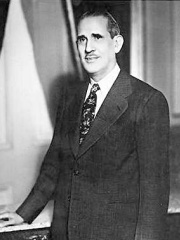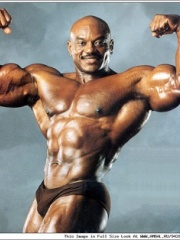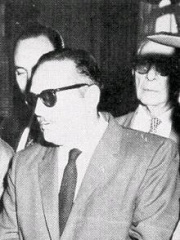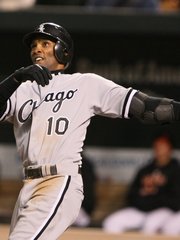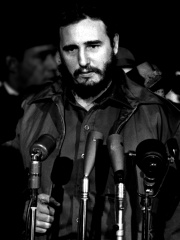
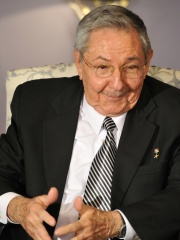
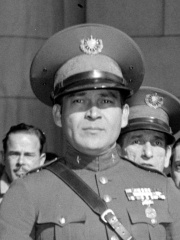
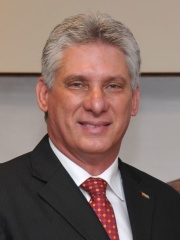
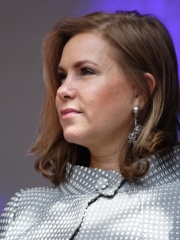
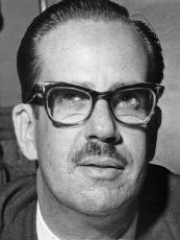
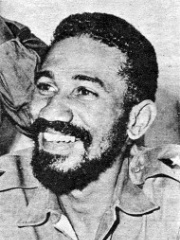
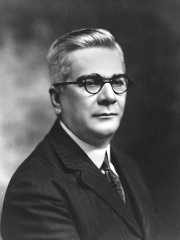
The Most Famous
POLITICIANS from Cuba
This page contains a list of the greatest Cuban Politicians. The pantheon dataset contains 19,576 Politicians, 51 of which were born in Cuba. This makes Cuba the birth place of the 64th most number of Politicians behind Venezuela, and Australia.
Top 10
The following people are considered by Pantheon to be the top 10 most legendary Cuban Politicians of all time. This list of famous Cuban Politicians is sorted by HPI (Historical Popularity Index), a metric that aggregates information on a biography's online popularity. Visit the rankings page to view the entire list of Cuban Politicians.

1. Fidel Castro (1926 - 2016)
With an HPI of 85.86, Fidel Castro is the most famous Cuban Politician. His biography has been translated into 153 different languages on wikipedia.
Fidel Alejandro Castro Ruz (13 August 1926 – 25 November 2016) was a Cuban politician and revolutionary who was the leader of Cuba from 1959 to 2008, serving as prime minister from 1959 to 1976 and president from 1976 to 2008. Ideologically a Marxist–Leninist and Cuban nationalist, he also served as the first secretary of the Communist Party of Cuba from 1965 until 2011. Under his administration, Cuba became a one-party communist state; industry and business were nationalized, and socialist reforms were implemented throughout society. Born in Birán, the son of a wealthy Spanish farmer, Castro adopted leftist and anti-imperialist ideas while studying law at the University of Havana. After participating in rebellions against right-wing governments in the Dominican Republic and Colombia, he planned the overthrow of Cuban president Fulgencio Batista, launching a failed attack on the Moncada Barracks in 1953. After a year's imprisonment, Castro travelled to Mexico where he formed a revolutionary group, the 26th of July Movement, with his brother, Raúl Castro, and Ernesto "Che" Guevara. Returning to Cuba, Castro took a key role in the Cuban Revolution by leading the Movement in a guerrilla war against Batista's forces from the Sierra Maestra. After Batista's overthrow in 1959, Castro assumed military and political power as Cuba's prime minister. The United States came to oppose Castro's government and unsuccessfully attempted to remove him by assassination, economic embargo, and counter-revolution, including the Bay of Pigs Invasion of 1961. Countering these threats, Castro aligned with the Soviet Union and allowed the Soviets to place nuclear weapons in Cuba, resulting in the Cuban Missile Crisis—a defining incident of the Cold War—in 1962. Adopting a Marxist–Leninist model of development, Castro converted Cuba into a one-party, socialist state under Communist Party rule, the first in the Western Hemisphere. Policies introducing central economic planning and expanding healthcare and education were accompanied by state control of the press and the suppression of internal dissent. Abroad, Castro supported anti-imperialist revolutionary groups, backing the establishment of Marxist governments in Chile, Nicaragua, and Grenada, as well as sending troops to aid allies in the Yom Kippur, Ogaden, and Angolan Civil War. These actions, coupled with Castro's leadership of the Non-Aligned Movement from 1979 to 1983 and Cuban medical internationalism, increased Cuba's profile on the world stage. Following the dissolution of the Soviet Union in 1991, Castro led Cuba through the economic downturn of the "Special Period", embracing environmentalist and anti-globalization ideas. In the 2000s, Castro forged alliances in the Latin American "pink tide"—namely with Hugo Chávez's Venezuela—and formed the Bolivarian Alliance for the Americas. In 2006, Castro transferred his responsibilities to Vice President Raúl Castro, who was elected to the presidency by the National Assembly in 2008. Castro died at the age of 90 from natural causes in November 2016. Castro was the longest-serving non-royal head of state in the 20th and 21st centuries and polarized world opinion about his rule. His supporters view him as a champion of socialism and anti-imperialism whose revolutionary government advanced economic and social justice while securing Cuba's independence from American hegemony. His critics view him as a dictator whose administration oversaw human rights abuses, the exodus of many Cubans, and the impoverishment of the country's economy.

2. Raúl Castro (b. 1931)
With an HPI of 80.27, Raúl Castro is the 2nd most famous Cuban Politician. His biography has been translated into 98 different languages.
Raúl Modesto Castro Ruz ( KASS-troh; Latin American Spanish: [raˈul moˈðesto ˈkastɾo ˈrus]; born 3 June 1931) is a Cuban retired politician and general who served as the first secretary of the Communist Party of Cuba, the most senior position in the one-party communist state, from 2011 to 2021, and President of Cuba between 2008 and 2018, succeeding his brother Fidel Castro. One of the military leaders of the Cuban Revolution, Castro served as the minister of the Armed Forces from 1959 to 2008. His ministerial tenure made him the longest-serving minister of the armed forces. Castro was also a member of the Politburo of the Communist Party of Cuba, the highest decision-making body, from 1965 until 2021. Because of his brother's illness, Castro became the acting president of the Council of State in a temporary transfer of power from 31 July 2006. Castro was officially made president by the National Assembly on 24 February 2008, after his brother, who was still ailing, announced on 19 February 2008 that he would not stand again. He was re-elected president on 24 February 2013. Shortly thereafter, Castro announced that his second term would be his final term, and that he would not seek re-election in 2018. He stepped down from the presidency on 19 April 2018 after his successor, Miguel Díaz-Canel was elected by the National Assembly following parliamentary elections. Castro remained the first secretary of the Communist Party; he was still considered the de facto leader of the country, retaining oversight over the president. Castro announced at the Eighth Congress of the Communist Party of Cuba, which began on 16 April 2021, that he was retiring. His successor, Miguel Díaz-Canel, was voted in on 19 April. Castro was also the head of the constitutional reform commission, and continues to have a seat representing Santiago de Cuba's Segundo Frente municipality in the National Assembly.

3. Fulgencio Batista (1901 - 1973)
With an HPI of 77.68, Fulgencio Batista is the 3rd most famous Cuban Politician. His biography has been translated into 83 different languages.
Fulgencio Batista y Zaldívar (born Rubén Zaldívar; January 16, 1901 – August 6, 1973) was a Cuban military officer, political leader and dictator who played a dominant role in Cuban politics from his initial rise to power in the 1930s until his overthrow in the Cuban Revolution in 1959. He served as president of Cuba from 1940 to 1944, and again from 1952 to his 1959 resignation. Batista first came to prominence in the Revolt of the Sergeants, which overthrew the provisional government of Carlos Manuel de Céspedes y Quesada. Batista then appointed himself chief of the armed forces, with the rank of colonel, and effectively controlled the five-member "pentarchy" that functioned as the collective head of state. He maintained control through a series of puppet presidents until 1940, when he was elected president on a populist platform. He then instated the 1940 Constitution of Cuba and presided over Cuban support for the Allies during World War II. After finishing his term in 1944, Batista moved to Florida, returning to Cuba to run for president in 1952. Facing certain electoral defeat, he led a military coup against President Carlos Prío Socarrás that pre-empted the election. Back in power and receiving financial, military and logistical support from the United States government, Batista suspended the 1940 Constitution and revoked most political liberties, including the right to strike. He then aligned with the wealthiest landowners who owned the largest sugar plantations, and presided over a stagnating economy that widened the gap between rich and poor Cubans. Eventually, it reached the point where most of the sugar industry was in U.S. hands, and foreigners owned 70% of the arable land. Batista's repressive government then began to systematically profit from the exploitation of Cuba's commercial interests, by negotiating lucrative relationships both with the American Mafia, who controlled the drug, gambling, and prostitution businesses in Havana, and with large U.S.-based multinational companies who were awarded lucrative contracts. To quell the growing discontent amongst the populace—which was subsequently displayed through frequent student riots and demonstrations—Batista established tighter censorship of the media, while also utilizing his Bureau for the Repression of Communist Activities secret police to carry out wide-scale violence, torture and public executions. These murders mounted in 1957, as socialist ideas became more influential. While exact numbers are unclear, estimates of the death toll attributed to Batista range from hundreds to up to 20,000 victims. Batista's efforts to quell the unrest proved not only ineffective, but his tactics were the catalyst to even wider resistance against his regime. During this time, revolutionary leaders Fidel Castro and Che Guevara, founders of the 26th of July Movement, began a revolution that saw a combination of peaceful protests and guerrilla warfare in both rural and urban areas of Cuba between 1956 and 1958. After almost two years of fighting, rebel forces led by Guevara defeated Batista's forces at the Battle of Santa Clara on New Year's Eve, 1958, effectively collapsing the regime. On January 1, 1959, Batista announced his resignation, fleeing the country to the Dominican Republic under the protection of Rafael Trujillo, before settling in Portugal, spending the rest of his life in exile until his death in 1973.

4. Miguel Díaz-Canel (b. 1960)
With an HPI of 74.68, Miguel Díaz-Canel is the 4th most famous Cuban Politician. His biography has been translated into 71 different languages.
Miguel Díaz-Canel Bermúdez (Latin American Spanish: [miˈɣel ˈdi.as kaˈnel]; born 20 April 1960) is a Cuban politician and engineer who has served as the 8th first secretary of the Communist Party of Cuba since 2021 and as the 17th president of Cuba since 2019. In his capacity as First Secretary, he is the most powerful person in the Cuban government. Díaz-Canel succeeded the brothers Fidel and Raúl Castro, becoming Cuba's first non-Castro leader since 1959 and its first non-Castro head of state since 1976. He has been a member of the Politburo since 2003. He served as Minister of Higher Education from 2009 until 2012, when he was promoted to Vice President of the Council of Ministers. A year later, in 2013, he was elected as First Vice President of the Council of State. In 2018, he succeeded Raúl Castro as President of the Council. Following the enactment of a new constitution, he assumed the newly (re)created office of President of Cuba. On 19 April 2021, he was appointed First Secretary of the Communist Party of Cuba following Raúl Castro's exit from the role, completing the transition to non-dynastic leadership in Cuba.

5. Emilio Mola (1887 - 1937)
With an HPI of 68.52, Emilio Mola is the 5th most famous Cuban Politician. His biography has been translated into 33 different languages.
Emilio Mola y Vidal (9 July 1887 – 3 June 1937) was a Spanish military officer who was one of the three leaders of the revolt coup of July 1936 that started the Spanish Civil War. After the death of José Sanjurjo on 20 July 1936, Mola commanded the Nationalists in the north of Spain, while Franco operated in the south. Attempting to take Madrid with his four columns, Mola praised local Nationalist sympathizers within the city as a "fifth column", possibly the first use of that phrase. He died in a plane crash in bad weather, leaving Franco as the pre-eminent Nationalist leader for the rest of the war. It was suspected that his death was a result of sabotage. However, this has never been proven.

6. Maria Teresa, Grand Duchess of Luxembourg (b. 1956)
With an HPI of 68.09, Maria Teresa, Grand Duchess of Luxembourg is the 6th most famous Cuban Politician. Her biography has been translated into 38 different languages.
Maria Teresa (born María Teresa Mestre y Batista; 22 March 1956) is a member of the grand ducal family of Luxembourg. She was Grand Duchess of Luxembourg as the wife of Grand Duke Henri from 2000 until her husband's abdication in 2025.

7. Osvaldo Dorticós Torrado (1919 - 1983)
With an HPI of 67.01, Osvaldo Dorticós Torrado is the 7th most famous Cuban Politician. His biography has been translated into 38 different languages.
Osvaldo Dorticós Torrado (Spanish: [osˈβaldo ðoɾtiˈkos toˈraðo]; 17 April 1919 – 23 June 1983) was a Cuban politician who served as the president of Cuba from 1959 to 1976. He was a close ally of Cuban revolutionary and longtime leader Fidel Castro.

8. Juan Almeida Bosque (1927 - 2009)
With an HPI of 67.00, Juan Almeida Bosque is the 8th most famous Cuban Politician. His biography has been translated into 32 different languages.
Juan Almeida Bosque (17 February 1927 – 11 September 2009) was a Cuban politician and one of the original commanders of the insurgent forces in the Cuban Revolution. After the rebels took power in 1959, he was a prominent figure in the Communist Party of Cuba. At the time of his death, he was a Vice-President of the Cuban Council of State and was its third ranking member. He received several decorations, and national and international awards, including the title of "Hero of the Republic of Cuba" and the Order of Máximo Gómez.

9. Gerardo Machado (1871 - 1939)
With an HPI of 64.97, Gerardo Machado is the 9th most famous Cuban Politician. His biography has been translated into 30 different languages.
Gerardo Machado y Morales (28 September 1871 – 29 March 1939) was a general of the Cuban War of Independence and President of Cuba from 1925 to 1933. Machado was elected president in 1924 as the leader of the Liberal Party, a moderate reform-oriented party. He entered the presidency with widespread popularity and support from the major political parties. However, his support declined over time and Machado took dictatorial powers. Despite promising to govern only for one term, he ran for re-election in 1928 and won a non-democratic election where the opposition was repressed. As protests and rebellions became more strident, his administration curtailed free speech and imprisoned, exiled, and murdered Machado's opponents. Ultimately, in 1933, Machado was forced to step down in favor of a provisional government headed by Carlos Manuel de Céspedes y Quesada and brokered by US ambassador Sumner Welles. Machado went into exile in Miami Beach, Florida.
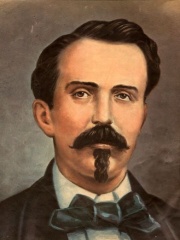
10. Carlos Manuel de Céspedes (1819 - 1874)
With an HPI of 64.94, Carlos Manuel de Céspedes is the 10th most famous Cuban Politician. His biography has been translated into 32 different languages.
Carlos Manuel de Céspedes del Castillo (18 April 1819 – 27 February 1874) was a Cuban revolutionary hero and First President of Cuba in Arms in 1868. Céspedes, who was a plantation owner in Cuba, freed his slaves and made the declaration of Cuban independence in 1868 which started the Ten Years' War (1868–1878). This was the first of three wars of independence, the third of which, the Cuban War of Independence led to the end of Spanish rule in 1898 and Cuba's independence in 1902. Because of his actions which led to the eventual independence of Cuba, and the fact that three of his children died during his long fight for independence, he is known there as the "Father of the homeland".
People
Pantheon has 51 people classified as Cuban politicians born between 1819 and 1989. Of these 51, 19 (37.25%) of them are still alive today. The most famous living Cuban politicians include Raúl Castro, Miguel Díaz-Canel, and Maria Teresa, Grand Duchess of Luxembourg. The most famous deceased Cuban politicians include Fidel Castro, Fulgencio Batista, and Emilio Mola. As of April 2024, 4 new Cuban politicians have been added to Pantheon including Alexei Ramírez, Yasniel Toledo, and Carlos Banteux.
Living Cuban Politicians
Go to all RankingsRaúl Castro
1931 - Present
HPI: 80.27
Miguel Díaz-Canel
1960 - Present
HPI: 74.68
Maria Teresa, Grand Duchess of Luxembourg
1956 - Present
HPI: 68.09
Aleida March
1936 - Present
HPI: 64.45
Manuel Marrero Cruz
1963 - Present
HPI: 64.17
Mel Martínez
1946 - Present
HPI: 63.72
José Ramón Machado Ventura
1930 - Present
HPI: 60.63
Salvador Valdés Mesa
1945 - Present
HPI: 60.36
Mariela Castro
1962 - Present
HPI: 56.71
Mireya Luis
1967 - Present
HPI: 53.94
Guillermo Fariñas
1962 - Present
HPI: 51.84
Alejandro Mayorkas
1959 - Present
HPI: 51.13
Deceased Cuban Politicians
Go to all RankingsFidel Castro
1926 - 2016
HPI: 85.86
Fulgencio Batista
1901 - 1973
HPI: 77.68
Emilio Mola
1887 - 1937
HPI: 68.52
Osvaldo Dorticós Torrado
1919 - 1983
HPI: 67.01
Juan Almeida Bosque
1927 - 2009
HPI: 67.00
Gerardo Machado
1871 - 1939
HPI: 64.97
Carlos Manuel de Céspedes
1819 - 1874
HPI: 64.94
Vilma Espín
1930 - 2007
HPI: 64.92
Tomás Estrada Palma
1835 - 1908
HPI: 64.39
Ramón Grau
1881 - 1969
HPI: 64.27
Sergio Oliva
1941 - 2012
HPI: 63.98
Manuel Urrutia Lleó
1901 - 1981
HPI: 62.23
Newly Added Cuban Politicians (2025)
Go to all RankingsAlexei Ramírez
1981 - Present
HPI: 36.04
Yasniel Toledo
1989 - Present
HPI: 34.52
Carlos Banteux
1986 - Present
HPI: 34.17
Lázaro Borges
1986 - Present
HPI: 33.25
Overlapping Lives
Which Politicians were alive at the same time? This visualization shows the lifespans of the 25 most globally memorable Politicians since 1700.

